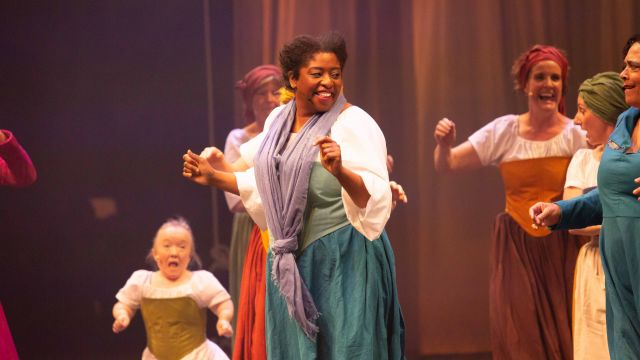Emilia
Morgan Lloyd Malcolm’s play places a welcome spotlight on the important figure of Emilia Bassano. Despite being a major influence on Shakespeare and possibly largely responsible for his talent, her position in history has been completely overlooked and ignored. The play sets out to right this terrible wrong. Emilia is yet another example of how women are written out of history to privilege male perspectives and positions of power in society. One of the most striking elements of this story is the forceful nature of Emilia’s protests given the ridiculously sexist context in which she lived. This play, therefore, has a fantastic feminist agenda and wonderfully claims Emilia’s right to be acknowledged and highlights her pleas for gender equality. Unfortunately, these pleas ring as true in a contemporary context as they did in her own time.

While the play has a very clear and admirable agenda the delivery of this story is less cohesive. Emilia’s part is performed by three different actors (Emilia 1 - Manali Datar, Emilia 2 - Cessalee Stovall, Emilia 3 - Lisa Maza) and this gives a great sense of the major stages of her life. This is one of the strengths of the production as each performer brings power, drama and passion to the role. The male characters are all played by women which gives them a very comical dimension. This works well in demonstrating the ludicrous and preposterous ways in which men often sustain their positions of power. However, this also tend to cast them as less menacing and their domination over Emilia, and women in general, is somewhat trivialised by these more comical elements.

The rage expressed by Emilia and the women who support her, seems out of context when juxtaposed with the cartoon-like depictions of the men. Shakespeare (Heidi Arena), for example, is depicted as little more than an opportunistic plagiarist. This is a very plausible contention but one that requires more depth and nuance in its exploration. Displacing such a central literary figure is a seriously important enterprise and the play limits its scope for achieving this.

The second act provides more grist for this unflattering perspective of male authority and focuses more on the evidence in the brilliance of Emilia’s writing. The many strong and feisty women in Shakespeare’s plays seem to echo through her words and this is an example of the play’s more persuasive moments. The story in the first act seems to be weighed down by some of the detail of Emilia’s long and eventful life and results in distracting from her rage. The setting is nicely evoked with the costuming and minimalist set; there is some clever use of drapery in the stage design but, on the whole, the stage appears somewhat sparse.

The play ends with a wonderful final speech by Emilia that reverberates throughout the entire auditorium. It clearly resonates with her own personal history but, judging from audience reaction, it also resonates with the lived experience of so many women. This play is a great opportunity to share and promote the right to such anger and exasperation. However, there are many theatrical devices and techniques that could have been employed to give this story the greater gravity and urgency it deserves.
Patricia Di Risio
Photographer: Dylan Hornsby | Good Gravy Media
Subscribe to our E-Newsletter, buy our latest print edition or find a Performing Arts book at Book Nook.

